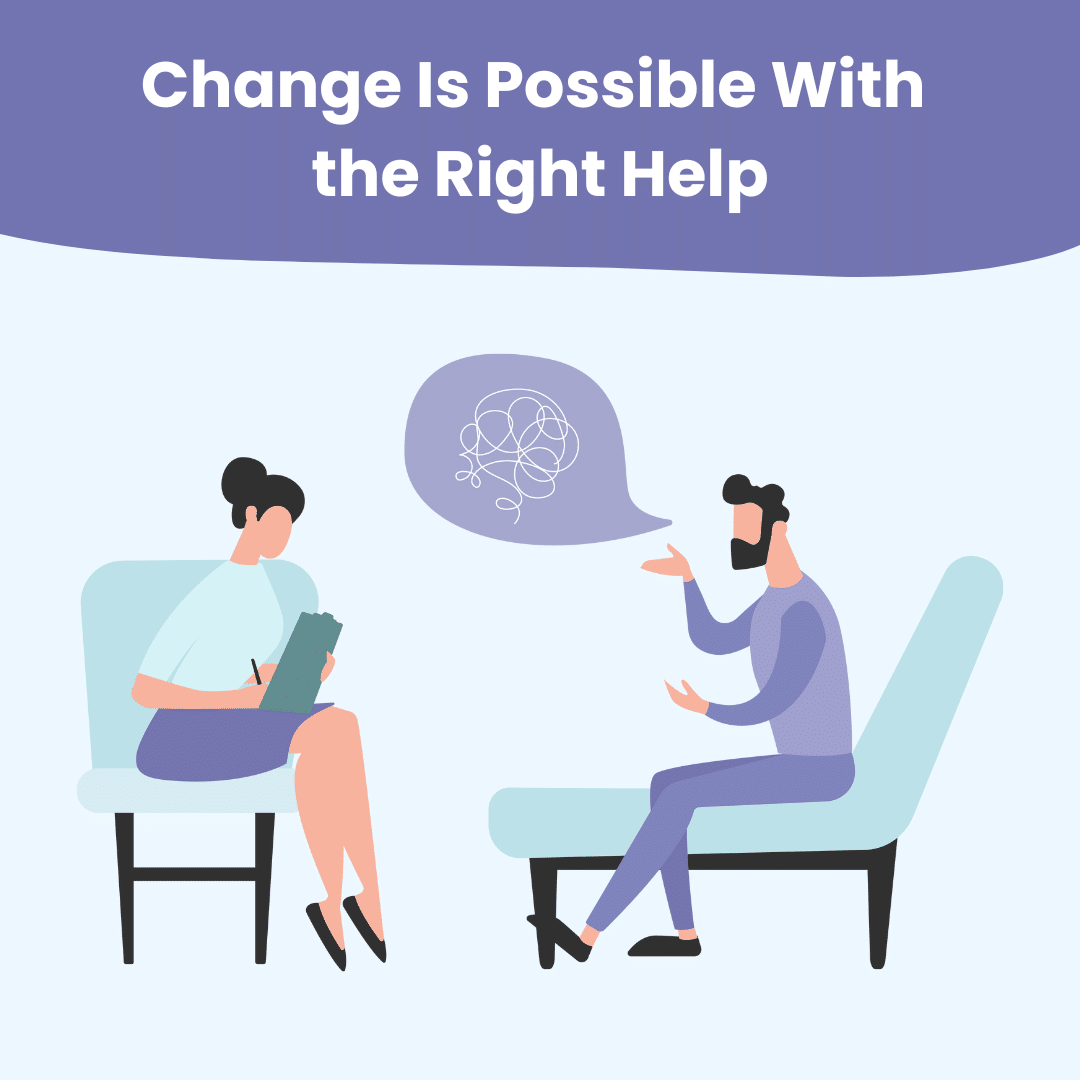
- Updated on 5 July 2024
From time to time, all of us feel mentally or emotionally burdened, be it from work, academic stresses, or relationships.
In recent times, many people have spoken out about mental health issues around the globe. This has fuelled an interest in personal therapy as an effective way to cope with the psychological and emotional issues that we face in our daily lives.
What is therapy? How can a Therapist in Singapore help? What are some types of therapy? These are some questions that we aim to answer in this article.
Here’s more information for those unsure about what therapy is and if therapy is for them, as well as 7 different types of therapy used by mental health professionals.
This Article Contains:
- What is Therapy?
- Therapy is for anyone
- Therapists don’t tell us what to do
- Therapy is more than just having a casual chat
- Therapy is a mature way of fixing a personal problem
- The length and frequency of therapy can vary
- Therapy doesn’t last forever
- Online therapy can be just as effective
- Different Types of Therapy
- Cognitive Behavioural Therapy (CBT)
- Mindfulness
- Psychodynamic Therapy
- Solution Focused Brief Therapy (SFBT)
- Person Centred Approach
- Eye Movement Desensitization and Reprocessing (EMDR)
- Systemic Therapy
- Frequently Asked Questions
What is Therapy?
What is therapy? There are countless types of therapy (see below).
The term ‘therapist’ is widely used. People wonder what occupational therapy, speech therapy, massage therapy, and physiotherapy is. The list goes on.
Therapy is also generally known as counselling or psychotherapy. In the context of emotional difficulties, therapy is a safe, confidential, and non-judgmental space.
Individuals may share their struggles and work towards a goal with a trained professional. This section introduces the types of trained professionals and what they do.
Psychiatrist. Diagnoses mental health conditions. Prescribes medication.
Clinical psychologist. Diagnoses mental health conditions. Manages more serious mental health disorders non-medicinally in the long term.
Professional counsellor. Uses integrative therapies to help people work through personal and emotional issues.
Social Worker: Works with and advocates for individuals and families. Liaises with various parties in the community on behalf of clients.
When looking for a therapist, you might find the terms ‘therapist’, ‘counsellor’, and ‘psychotherapist’ used interchangeably. What is most important is trust.
Look for a therapist you can trust. This is because your relationship with your therapist will be a key factor affecting the outcome of therapy.
Therapists help their clients develop emotional resilience and cognitive skills to alleviate distress and help them achieve their personal goals and potential.
They use different therapeutic modes to:
- Provide a fresh perspective on issues
- Help us develop self-awareness to better understand our behaviour, thought patterns and emotions
- Improve our communication skills so we may convey ourselves more constructively
Therapy is for anyone
Therapy isn’t the only way to manage all mental health issues.
Different strategies work for people who want to maintain good mental health, including yoga, self-care, mindfulness and journaling.
However, if someone hasn’t felt like themselves for more than two weeks, a check-in with a therapist may be a suitable option.
For example, if they have been:
- Sleeping a lot more or less than usual
- Feeling irritable
find themselves snapping all the time - Feeling sad for no reason
You may wish to learn more about the warning signs to look out for.
Therapy in Singapore is not only reserved for people who have been clinically diagnosed with mental illnesses or mental disorders.
It is common to think, “My situation is not bad enough to go for therapy,” or hear this from your loved ones.
This may be a good time to gently remind ourselves and those close to us that things don’t have to get worse before they get better.
Therapists don’t tell us what to do
It is not uncommon to find ourselves asking questions such as:
- Why do I feel sad for no reason?
- Why do I end up with narcissists or end up in abusive relationships?
- What is the meaning of life?
- Why do I push people away?
There must be a reason why we can’t help but feel anxious or depressed over a certain situation we are facing.
There must be a reason why we may feel continuously helpless or indulge in self-defeating and maladaptive behaviours.
Therapists are equipped with skills to help us gain a deeper understanding of ourselves and gain self-awareness. Good therapists don’t tell us what decisions we should make or how we should feel about situations.
Instead, they help us develop useful skills that we may not have had the fortune to inherit or stumble upon.
Therapy is more than just having a casual chat
We may go to counselling in Singapore and start by casually discussing how messy our lives are or ranting about our difficult experiences.
However, how a Therapist responds is different from how your friend would.
Psychotherapists in Singapore are professionally trained in different types of therapy to help you with any emotional or psychological difficulties you may be facing.
Therapists are also required to adhere to professional and ethical obligations, including that of confidentiality.
Your time spent with your therapist is focused on you – your hopes, desires and fears. It is not like a two-way conversation with a friend.
Singaporean Therapists are trained to help you through your personal issues without any bias, judgement or discomfort.
They are also objective – having no personal stake in your decisions, perspectives or values, they help to uncover your true self to yourself.
It can get uncomfortable during therapy because, for any therapy to work, we must trust our therapist and open up our deepest wounds to them.

Therapy is a mature way of fixing a personal problem
Struggling with a mental health issue, or indeed seeking therapy in Singapore, does not make one weak or ‘defective’ in any way.
What matters more is the maturity and resilience that one shows in dealing with the issue, like any other life challenge.
Maturity is when we are unafraid to accept our own trauma, grief and pain and actively seek help before it affects us further.
It requires a clear and honest analysis of ourselves, coupled with strength and courage, to be able to fight our battles head-on.
By employing professional help, we are not only acknowledging that an issue is weighing us down in some way, but we are also working on it to find appropriate solutions.
You May Like Reading: Do I Need Therapy?
The length and frequency of therapy can vary
There is no rule around how long therapy will take or how frequent it should be, as it would depend on the issues faced by the client, their personal goals and the improvements observed.
We provide some research-backed guidance below.
Length
Mental health research indicates that after an average of 8 sessions (Foundation Psychology; Saxon et al., 2016), individuals report the greatest decrease in psychological distress and are most likely to experience positive changes in their lives.
Time is needed for therapists to understand our personal story and history. It is also important to remember that progress looks different for each of us. We also need time for us to make changes in our lives and break unhelpful patterns.
It may also be helpful to note that individuals who decide to withdraw within or just after 3 sessions are less likely to experience positive outcomes as things often start taking a turn for the better after the third session (Crago & Gardner, 2012).
Frequency
In terms of frequency, at the start, individuals can consider going for therapy once a week.
Research suggests that weekly sessions allow regularity, which is highly beneficial to clients, particularly at the beginning of the therapeutic journey.
Having regular weekly sessions develops one’s emotional safety (Cameron, 2018) and enables one to build trust and rapport with one’s therapist (Hall, 2020).
This allows one to progress at a steady pace and ensures that during sessions, more time can be dedicated to working through one’s issues rather than filling the therapist in about the time that has elapsed.
Moreover, weekly check-ins reduce the possibility of slipping into bad habits or becoming overwhelmed by unwanted thoughts and feelings. Visit our obsessive-compulsive disorder page to read more.
Nonetheless, committing to therapy in Singapore is an investment of both one’s time and financial resources. You may want to speak with your therapist and come up with a plan or schedule that works best for you.
Therapy doesn’t last forever
Therapists certainly do not encourage long-term dependence on them. It can be a lifelong effort on our part to work on the issues we face, but the work of a therapist ends when we have learned the necessary skills for doing so.
Depending on the type of therapy we receive as well as the complexity of the problems we face, the amount of time needed may vary from person to person, but there is an end to therapy.
Goals are always set so that we get a gauge of how far or how near we are from ‘the end’. These goals can be specific, like controlling anger in a relationship, or more broad-based goals, such as rediscovering joy and happiness, improving our relationships or better regulating our emotions.
Therapy generally ends when the client’s goals have been achieved.
Online therapy can be just as effective
For the vast majority of us, other than wondering what is therapy, we question if online therapy is the same as in-person.
As long as we are able to find a comfortable and private environment, talk therapy is as effective, whether it is conducted online via video-conferencing, voice call, live texting, or in-person.
Indeed, the added convenience, anonymity and affordability when talking to the Singaporean Therapist online may even allow us to feel more at ease and thus improve the effectiveness of the therapy sessions.
Online counselling in Singapore can be more time efficient as well. Not only can we fit therapy sessions into our schedules more easily without having to take leave from work, but it also removes the need to travel.
Additionally, there will be no need to explain our stories again when changing therapists within the platform should we agree to allow our previous therapist to share session notes.
Read more about the benefits of online counselling.
Different Types of Therapy
Therapists use different types of therapy, or a mix of approaches. This section explains 7 commonly used therapeutic approaches.
Cognitive Behavioural Therapy (CBT)
Cognitive Behavioural Therapy (CBT) suggests that our thoughts, emotions, and behaviour all affect each other.
CBT is predicated on the idea that the challenges we face stem from our thoughts and beliefs. Thus, reframing our unhelpful thoughts reduces our difficulties (Dawson, Moghaddam & Przepiórka, 2015).
Individuals have different belief systems, which result in other emotions and actions even in similar situations.
For example, John was often criticized by his parents as a child. Thus, he internalised the core beliefs that he was ‘worthless’ and ‘useless’. When John failed exams, he thought it was because he was ‘inferior’.
He felt sad and frustrated. To feel better, John started to smoke and drink. The more he smoked and drank, the more ‘useless’ he felt. Hence, a vicious cycle followed.
To get rid of his negative emotions, he engaged in harmful behaviours. This reinforced his feelings of sadness and frustration. He then believed that he was ‘inferior’.
CBT identifies and reframes unhelpful thoughts and beliefs into healthier alternatives. This changes the resulting emotions and actions.
CBT has been recommended for treating anxiety disorders and low to moderate levels of depression (NICE, 2009). It is an evidence-based practice that is largely effective.
Visit our depression counselling and anxiety counselling page to learn more.
Mindfulness
Mindfulness has its roots in Buddhism (Guendelman, Medeiros, Rampes, 2017).
According to Davis and Hayes (2011), mindfulness is ‘a moment-to-moment awareness of one’s experience without judgment’. In other words, to be mindful is to be truly present in the moment and to be aware of what one is doing, thinking and feeling.
Some ways to practice mindfulness include taking a few minutes to breathe in and out deeply.
Truly focus on your thoughts and feelings. Let them come and go without judging or analysing them. Be aware of your senses. Listen to the sounds in your surroundings. Feel the connection of your feet to the ground.
Mindfulness allows individuals to better regulate and cope with their feelings (Guendelman et al., 2017) by mitigating strong negative emotions.
Being present in the moment helps to reduce automatic behaviours. If the driver in front of us brakes suddenly, we tend to react with anger automatically.
However, practising mindfulness allows us to choose how we wish to respond intentionally. Responding calmly rather than angrily may promote better mental well-being in the long run.
Mindfulness has been integrated into various therapies. Examples include Mindfulness-Based Stress Reduction (MBSR), Mindfulness-Based Cognitive Therapy (MBCT) and Acceptance and Commitment Therapy (ACT).
Although these therapies vary in technique and preferred outcomes, mindfulness is at the core of them all.
For example, MBCT integrates both mindfulness and CBT. It guides clients to identify and recognise negative thinking patterns, such as rumination (ie constant worrying thoughts) or thought suppression.
Clients are then taught skills to disengage from these automatic and dysfunctional patterns via meditation (Barnhofer et al., 2009).
Mindfulness is effective in decreasing the rate of relapse from depression (Williams et al, 2008). It is also useful for dealing with depression, stress and anxiety.

Psychodynamic Therapy
Psychodynamic therapy addresses unconscious conflicts that may have arisen during an individual’s early relationships and that are still impacting their current life (Lake & Whittington, 2015).
For example, it looks at how our relationships with our parents affect our current lives.
Children of neglectful parents tend to grow up being emotionally distant.
Hence, psychodynamic therapy aims to highlight unhelpful and internalized behaviours. This is done by bringing them to a client’s consciousness.
Clients are then guided to form new meanings and experiences (Lake & Whittington, 2015).
Principles of Inner Child Work
The concept of an ‘inner child’ looks at the child inside of us – the child we once were.
Although many of us might consider ourselves grown adults, our lives are constantly influenced unconsciously by our inner child (Diamond, 2008).
The pain, trauma and emotional burdens felt during childhood continue to impact us as adults. Inner child work hence ‘involves the patient using their adult self to re-parent their inner child’ (p.1) with the Singaporean therapist helping alongside (Mahadevan, 2012).
It is thus important to first recognize the needs of the inner child. One can then work towards reconciliation between the two selves (Diamond, 2008).
This allows the person to grow and truly heal. Mahadevan (2012) suggested that it was crucial for his participant to ‘connect with her inner child” and to “feel her feelings which she had suppressed for a long time as a child’.
Solution Focused Brief Therapy (SFBT)
Solution Focused Brief Therapy, as the name suggests, focuses on the possible solutions a client may choose.
The problem thus lies not in the client but in the solution. Effective solutions should achieve positive results. If not, they should be changed.
Hence, unlike traditional models exploring problems’ origin and maintenance, SFBT looks at what clients can do to achieve desired outcomes.
In SFBT, the therapist asks questions that help clients identify their strengths and resources. An example is, “You were able to abstain from alcohol at home; what’s different here?”.
The following section covers SFBT techniques adapted from de Shazer and Berg (1997) and Kim and Franklin (2009).
SFBT Techniques
The miracle question: Clients are asked to think about how different their lives would be if the problem did not exist. This helps them form a clear and realistic goal to achieve their desired outcome (Hopson & Kim, 2004).
Scaling questions: Clients are asked to rate their progress (e.g., on a scale of 1 to 10). This allows them to track their efforts. Scaling questions uncover possible solutions (Hopson & Kim, 2004) by revealing what does and does not work.
Evaluation and giving compliments: Clients are praised for their strengths. This empowers them. It also highlights their resources (Hopson & Kim, 2004).
Giving homework: The therapist in Singapore assigns an activity for the client to try. This is based on what the client decides is beneficial or not in seeking effective solutions (Hopson & Kim, 2004).
Setting targets: Goals must be practical and realistic. They must also come from what clients believe will work. This increases clients’ motivation and involvement (Hopson & Kim, 2004).
Questioning about exceptions: The therapist examines when the problem is absent and how this absence occurred. This helps clients realise that they already have resources to address the problem (Hopson & Kim, 2004).
Once the client is aware of and cherishes minor improvements, more changes will occur, creating a ripple effect (Bannink, 2007).
Bannink (2007) also emphasises the client as the driver of effective solutions. In other words, “the client is the expert” (p. 88). Also, the client “defines the goal for treatment” (p. 88).
SBFT is useful and effective for “drug dependence, alcohol addiction, depression, relationship problems, relationship breakdown, eating disorders, crisis and anger management” (Arslan and Ulus, 2020, pp. 3).

Person Centred Approach
Person-centred therapy, developed by Carl Rogers, emphasises the client taking the lead while the therapist follows, helping clients find their own answers (Joseph, 2015).
Rogers proposes that an individual has their own subjective reality, which can only be understood from their own conscious experience (Funder, 2015).
He also suggests that a person’s main purpose is to fulfil one’s true potential — or to “actualise” one’s life (Funder, 2015).
One way to practice this approach is Socratic questioning. This allows one to uncover useful answers (Padesky, 1993).
New information surfaces when questioning the validity of and assumptions behind clients’ beliefs.
Padesky (1993) explains that this is not to “change the client’s mind” (pp. 3). Instead, it is to “understand the client’s view of things” (pp. 3). This results in a collaborative effort to make changes.
Eye Movement Desensitization and Reprocessing (EMDR)
EMDR is based on the Adaptive Information Processing Model. The model argues that previously stored repressed emotions, sensations or beliefs may have memory links to current experiences, which distort the current reality (Shapiro, 2014).
EMDR processes these repressed memories via ‘bilateral stimulation’. The client recounts traumatic experiences while following the therapist’s hand movements or listening to bilateral sounds (Crowley and Santos, 2015).
This desensitises clients to their negative emotions. It also allows clients to reprocess and create new links for their memories.
Research has demonstrated EMDR’s effectiveness for psychological trauma (eg post-traumatic stress Disorder) or negative life experiences by treating repressed memories (Shapiro, 2014).
Systemic Therapy
Systemic therapy considers the system an individual is in. This is in contrast to focusing solely on the individual. Systems include relationships, family, and organisations.
Systemic therapy examines how the system, or the relationships in the system, might perpetuate the problems faced.
Treatment focuses on working with the system to bring about changes (Lake & Whittington, 2015). For example, parents who argue often might add to their children’s anxiety. Check our Singapore child psychologists page for more.
Systemic therapy would then involve helping the parents to respond appropriately to their children’s behaviours. It would also help the parents manage their own emotional difficulties better.
Also See: Why Does My Mom Hate Me? Reasons You May Feel This Way
Takeaway
Therapy is a safe and confidential space where you can work with trained professionals to address emotional and psychological challenges.
Various professionals offer therapy, including psychiatrists, clinical psychologists, professional counsellors, and social workers. Finding a therapist you trust is important, as your relationship with the therapist can determine the effectiveness and outcome of therapy.
Remember, therapists are there to help you devise effective solutions to your problems. They also help you better understand yourself and develop the skills to navigate life’s challenges.
The duration and frequency of therapy may vary depending on your preferences, issues, and other factors. At Talk Your Heart Out (TYHO), we offer both in-person and online therapy to help you heal, cope, and thrive in life.


Frequently Asked Questions
Why is mental health important?
Our mental health is important as it influences and determines how we think, feel, and behave.
Prioritising our mental health positively impacts several aspects of our lives. Having good mental health boosts our productivity, helps us foster healthy relationships, and allows us to stay resilient amidst life’s challenges.
Read: Why You Procrastinate and How to Stop
Conversely, having poor mental health lowers our focus and motivation and impedes our ability to tackle our daily stressors.
In the long term, it can lead to severe emotional and physical health complications.
One may engage in self-defeating behaviours (eg physical neglect, excessive self-criticism) or even resort to unhealthy coping mechanisms (eg alcohol, drug use) to manage difficult emotions.
How do I get a mental health diagnosis?
Online mental health self-assessments are a quick and convenient way to find out if you are experiencing symptoms of a mental health issue. However, they do not provide you with an actual diagnosis.
You may wish to visit a psychologist in Singapore or a psychiatrist for a mental health diagnosis. They are mental health professionals best placed to assess both your feelings and behaviours and determine the state of your mental health.
As mental health is complex and symptoms of mental health disorders often differ between individuals, it may take several assessments before you receive your complete diagnosis.
Even then, your diagnosis is still subject to change, particularly if new symptoms show up over time.
At times, you may also be required to undergo a physical check-up to draw out physical ailments contributing to your symptoms, if any.
The process of getting a diagnosis can be arduous. Many a time, you will be asked to share your innermost struggles and confront difficult experiences.
Being diagnosed with a mental disorder may also leave you feeling lost and confused or even ashamed. However, always remember that you are not your mental disorder.
You are simply an individual with a mental disorder, and a courageous one at that, for seeking support.
What does a mental health counsellor do?
A mental health counsellor is a trained professional who works with individuals experiencing various personal and emotional issues (eg feeling emotional all the time).
Beyond providing a listening ear, they draw from several integrative therapies to help you see things from different perspectives and gain deeper self-awareness.
A counsellor also gives you mental health tips and guides you along as you set goals and action plans to enhance your overall well-being.
Nonetheless, a counsellor does not tell you what to do or how you should feel. Rather, they offer a safe and non-judgmental space fo share your emotions and experiences honestly.
Over time, your therapeutic journey is meant to help you build internal resources and develop skills to manage the challenges you are faced with.
How to prepare for therapy sessions?
Anticipating your first therapy session in Singapore can fill you with nervousness and apprehension.
Experiencing such feelings is completely normal, particularly if you are unsure of what to expect.
That said, there are still steps you can take to prepare better prepare yourself and make the most out of your session.
Some tips include:
- Envision your goals: Think about what you hope to get from therapy. It is natural for your thoughts to be all over the place before your first session. You may even wonder if it’s too early to start envisioning goals. Nonetheless, envisaging an outcome prepares you for your first conversation with your therapist. With knowledge of your purpose for seeking therapy, they can also better devise a therapeutic plan for you.
- Keep an open mind: Counselling sessions often reveal insights about ourselves in ways that we may not have expected. Be honest with yourself. Keeping an open mind invites new ideas, possibilities and experiences, which help to foster self-growth. Your Therapist in Singapore may also ask you more questions during your first session to better assess and understand your situation.
- Ask questions: Don’t be afraid to ask questions. Clarifying your doubts during the session, whether about therapy itself, appointment frequency, or payment, relieves you a great deal of uncertainty after the session. What’s more, receiving clear answers from your therapist allows you to plan your subsequent sessions more swiftly.
If you are keen to learn more about how to prepare for different types of counselling sessions (eg individual counselling, couples counselling), further information can be found here.
How long are therapy sessions?
Most individual therapy sessions run for 50 to 60 minutes. Couples or family counselling sessions, however, may run longer (eg 90 mins).
All sessions at Talk Your Heart Out (TYHO) are an hour long.
There are a few reasons for keeping to hour-long sessions. Some clients may feel overwhelmed when they are made to discuss deeply personal and emotional issues, often including traumatic experiences, for more than an hour.
Limiting sessions to an hour allows them to discuss, feel, and contain their emotions with a clear endpoint in mind, such that resuming daily activities after would be less tedious.
Adhering to such session length also encourages clients to dive more directly into their issues, which in turn helps therapists to absorb what they have shared and offer insights with greater ease.
Altogether, it ensures that both clients and Therapists stay focused across the hour and reduces the chances of an information overload.
How much do therapy sessions cost?
On average, an hour-long therapy session is priced between $100-$300 for individual counselling and $180-$400 for couples counselling.
Some counselling centres utilise a sliding scale structure, where fees are often adjusted according to a client’s income.
When in doubt, seek clarification from the respective service teams.
At TYHO, the fees for our individual counselling sessions start from S$ 130.80 (w/GST) and for our couples counselling sessions from S$ 152.60 (w/GST).
Package pricing is also available for both session types. For more pricing-related information, please click here.
When is mental health awareness month?
In the United States, Mental Health Awareness Month is celebrated in May.
Events and activities to raise mental health awareness are usually planned during this time of the year.
Collectively, they aim to show support for individuals with mental health issues, normalise conversations around mental health and wellbeing, and reduce the stigma surrounding seeking professional help.
Across many parts of the world, as well as in Singapore, World Mental Health Day is also celebrated on 10 October each year.
Mental Health Awareness Month and World Mental Health Day are important initiatives.
While mental health should always be a priority, many often feel afraid to admit their vulnerabilities and tend to trivialise their emotions. Some may even find the topic taboo or foreign.
Such observances thus establish the universal significance of mental health, provide a platform to mobilise wellbeing efforts and encourage more workplaces and individuals to commit to self-care.
Visit our Singapore Therapist page to read about the different types of services we offer.
Related Articles
Latest Articles
Recent Posts
- A Therapist’s Guide to Setting Boundaries with Parents
- Anger Management in Singapore: Top 6 Benefits
- Individual vs Group Counselling in Singapore: What’s Right for You?
- Thinking of Switching Your Therapist in Singapore? Read This First
- How Counselling in Singapore Can Help You Overcome Dating Anxiety


